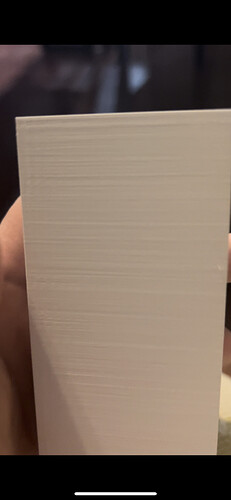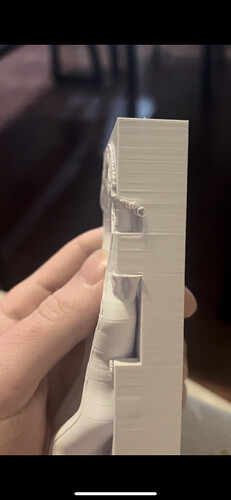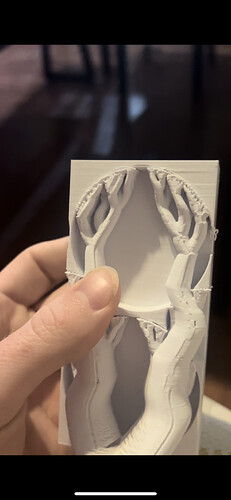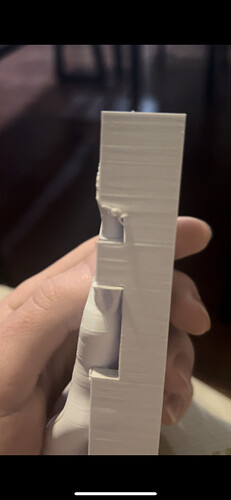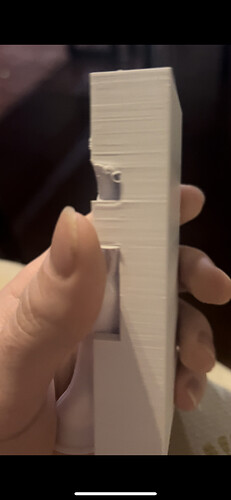I’m having serious adhesion issues since the firmware update. Tried every troubleshooting thing suggested in a Bambu Facebook group (others having the same issue). Where do you find the previous firmwares to roll back? Had my X1 for 6 months no issues, now can’t get a single print to work. It’s like the nozzle is too far away from the plate and the filament isn’t sticking to the build plate.
The Bambu Handy app is where you should be able to roll back the firmware. I would suggest a factory reset but I’ve heard you can’t roll back after that so take that as a warning.
I updated to 1.7.01.00 today, and restored factory settings before calibrating. The rollback options offered in the Handy app are v01.07.00.00 or v01.06.05.01.
I have not had a need to see if either of those options actually work.
Thank you for clarifying that.
I came here to post exactly what the OP posted. I too had a LOT of Filament error messages and all I had to do was to tap Retry in most cases. But a couple of times the AMS did NOT retract the filament on the spool. This happened on the second “7” update. What a PITA on a multicolor print. I, too, reverted back to the version just before the Motor ‘quietening’ load. Running a multicolored print now and hope it works correctly.
Guess I’ll wait until I hear they have this bug corrected.
Did you try power a cycle after the update? This often helps to flush out AMS issues. It’s odd as I’ve updated and had zero issues or warning messages. I specifically didn’t factory resent this time to see if this would introduce any problems. So far zero issues and the printer just prints away quietly as happy as can be. I’m looking forward to the new firmware for the P series.
Same for me as for Jon. Except i have never done a factory reset ever on this X1C. I have no personal presets or changed any gcode. ABS only.
She just prints!
Yes, I always cycle the power, do a calibration, and power cycle once again before printing.
Hold the phone, Batman! I may have found the issue causing my problem and it was Self Induced. I had printed and installed a curved piece to help guide the PTFE into the extruder. I noticed that when loading a filament that when it went through that curved radius that the feeding speed slowed down drastically.
I’m going to print another item before removing it, just to see if I get a feed failure. But I’m pretty sure I am the cause of the problem and not the software. One month in and learning a bunch, I think.
I had no mods on my printer, since I reverted back to the old firmware I have not had an issue since. There’s definitely something going on with the firmware. I replaced almost everything from the ams to the extruder. Including the ptfe tubes, nozzle, the hub. Restarted multiple times. Calibrated multiple times. I even tried mods to resolve the issue. Nothing worked. Only solution I have found was to revert to the old firmware. I suspect it has something to do with the motor noise reduction.
Glad you got it figured out! @Chris1974 made a really good post about this recently. It’s really easy to fall down the moding rabbit hole but that one ptfe guide has been the cause of other users issues as well.
I’ll throw my hat in the ring with folks that are having issues with recent firmware(s). I updated yesterday when prompted, didn’t run the prompted calibration after, because it said the motor noise cancellation calibration was a new feature - and I had already run it before updating the firmware. I’m starting to think that was a mistake.
I’ve had several problems related to the AMS whereas I’ve never had a single issue before. I’ve had ams assist motor overload warnings and the filament loads and unloads at random times now. On a single color print I’m running right now, it loaded the filament, went into the clean nozzle routine, retracted the filament, moved the head around, reloaded the filament with the nozzle at 140°C, leveled the bed, and then went into the pushing the filament / purging the old filament mode, and then started the print just fine. Super weird.
The current print is running fine - I’m going to let it run to see if it finishes. And, as I type this, I got the AMS assist motor is overloaded again. It’s happening on both of my AMSs.
Going to roll back the firmware tomorrow morning and give it another go. It’s possible it’s something physical, but absolutely nothing changed other than the firmware, and I had been printing for several days continuously before that.
Hopefully it’s a simple fix.
Reading the comments makes me think that perhaps the newer firmware isn’t moving the head as far into the cut filament corner as the prior firmware. And this isn’t completely cutting the filament.
This should be easy to test.
I’d try it myself, but after my own firmware downgrade fiasco, I’ll avoid doing this again until I’m forced to do it.
Updated to firmware 01.07.01.00 shut down and calibrated the machine. Printed two dual colour items with 100% success. All working fine for now.
I’ve now done the same. Shut the machine down, made sure all the plugs on everything were tightly seated, fired it up, ran all the calibrations, and then started a two color print.
Print completed just fine, although I did notice when the 2nd AMS (B) is feeding filament, the lights on the 1st AMS dim a bit. Not sure it was doing that before.
I’m running a multicolor print now using all four colors in the 1st AMS, and will do the same for the 2nd, and then run an 8 color after that just to make sure I’m back in business.
If you are using the textured plate bump up the bed temp to 65°
Under the speed settings set your number of slow layers to 3 or 4, it will start out with the slowest speed and gradually increase to full speed
Under your filament settings no cooling for the first 2 layers
And it helps to bump up your print temps by +5 or 10° depending on what filament and brand you are using
Bambu filament is pretty dialed in already regarding the print temp
Regardless though, when I’m using the textured PEI plates for PLA I’m at 65° for all of the different brands of PLA or PLA+
Great information. I’m a total novice at 3D printing, 6 month experience, only with1xc. I use PEI plate, works great. However, when PLA silk retracts it leaves strings in extruder, next filament can’t load into extruder. Temps are 220 n 50. For some reason B studio sets plate at 55, printer gives message plate temp too high could cause extruder clog. I change plate to 50. Should I leave it at 55?
What do you think? Thank you. Jean
Silk is a different animal
Run your textured plate at 65
Print temp 230
Outer wall 145mm/s inner 215mm/s
In the quality section do all line widths at 0.4mm except for first layer at 0.48mm and top surface at 0.35mm
Silk prints best hotter and slower than regular PLA
A good indication of proper temps with pla is a consistent glossy finish
But with silk I judge my temps by lighter or darker shades of the same color
The darker the better, a lighter shade means its cooled too much or more than the darker counterpart
Thats a visual method, the correct yet time consuming method are temp towers
I use a lot of different types of filaments and that’s alot of temp towers which equals quite a bit of time and materials
I noticed the surface color and gloss on my temp towers regarding quality so by cutting a corner so to speak I’ve sped up my troubleshooting substantially
In my experience and opinion with the X1C 220° is the absolute minimum print temp for PLA
If your hot end is too cool it will build up pressure in the throat during multiple retractions which increases stringing and quality issues and possibly jams if it creeps up the hotend too much (pressure below the filament is bad news)
Obviously too hot is another discussion but I just wanted to explain my suggestion for hotter and slower with silk for better quality with less defects or issues in doing so
Merry Christmas by the way ![]()
On a side note
Make sure you’ve got the correct build plate selected in your slicer
Thank you. Best Christmas present ever!
Super clear explanation. I’m printing and putting in the notebook.
Happy Holidays
Jean
